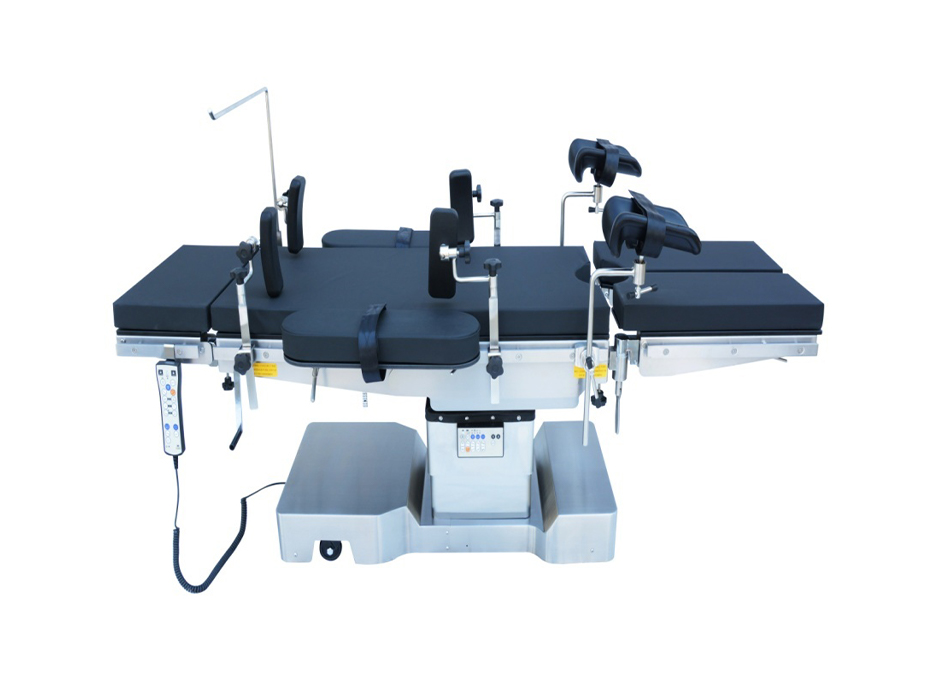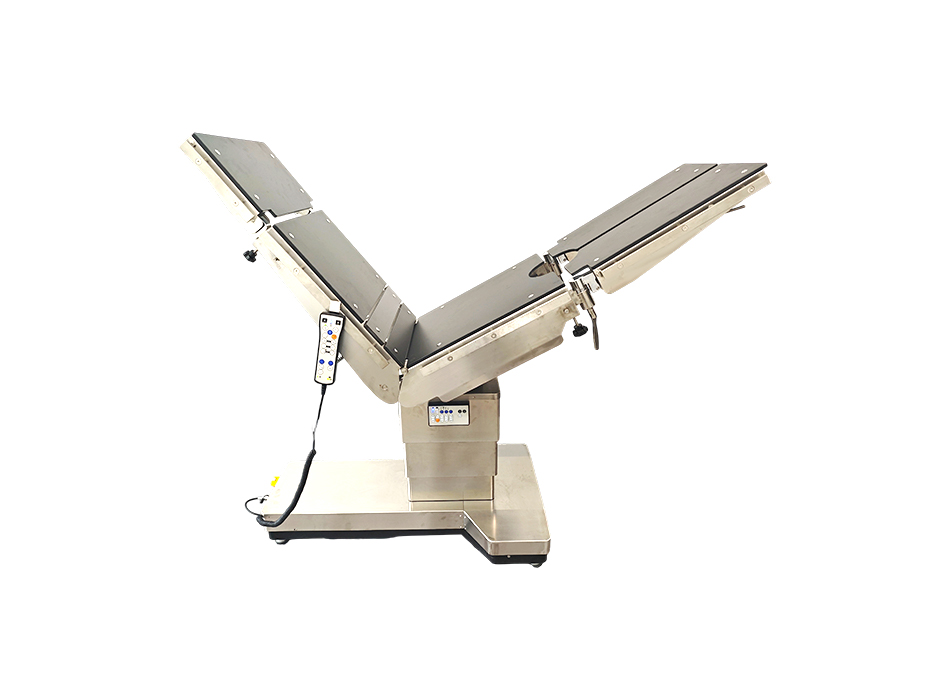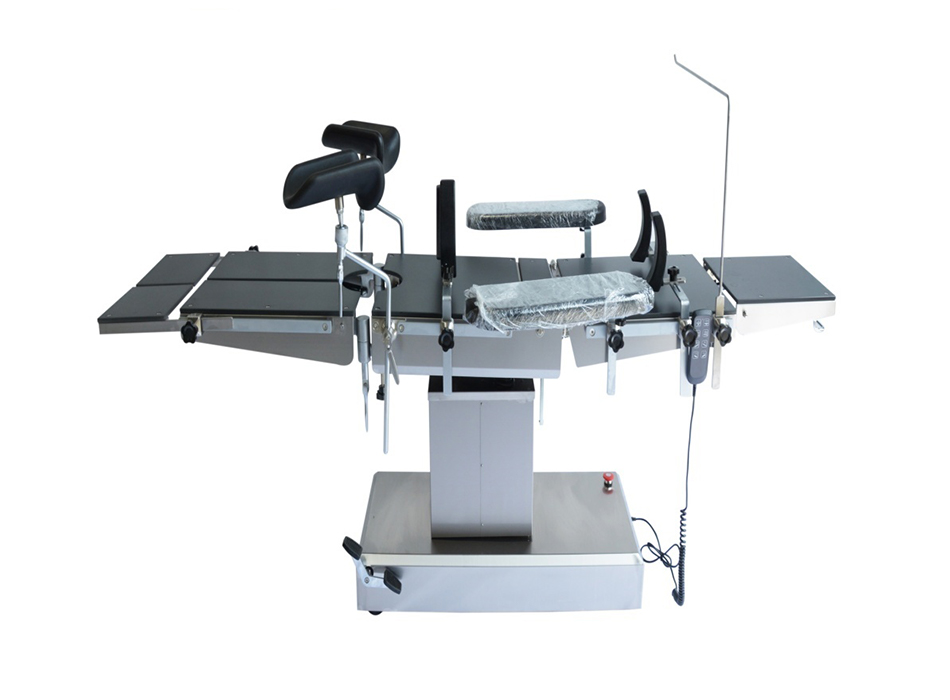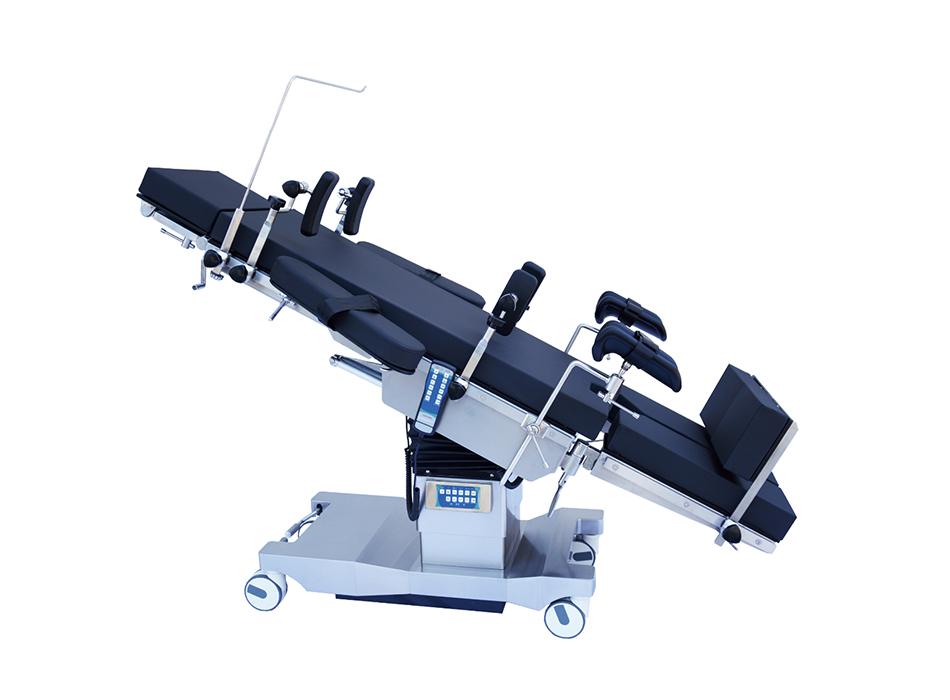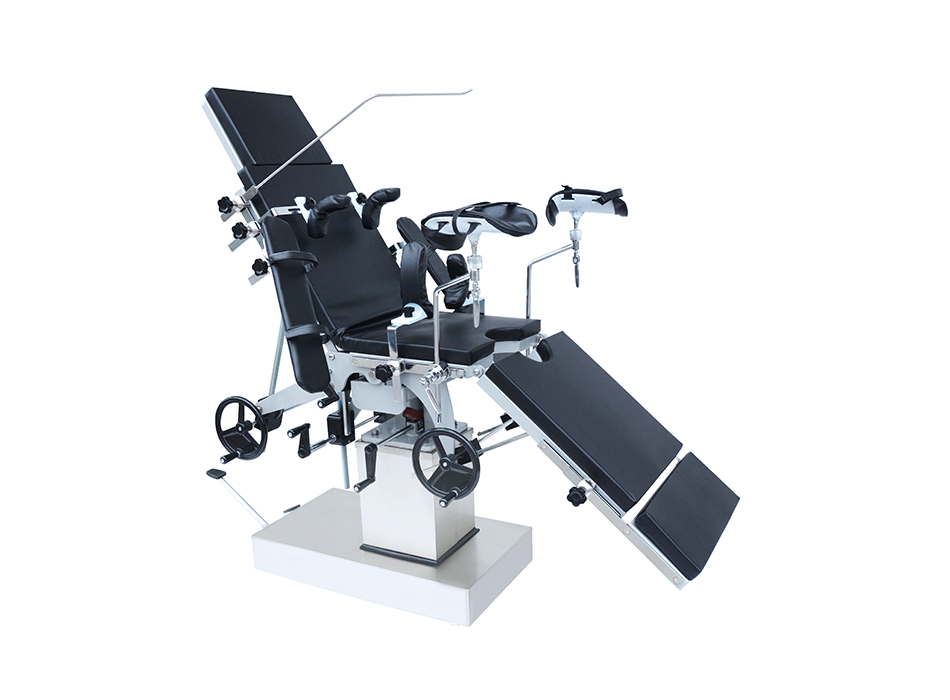 Welcome to Jiangsu Yigao Medical
Welcome to Jiangsu Yigao Medical
 E-MAIL:[email protected]
E-MAIL:[email protected]

The electric delivery table is an essential piece of hospital equipment used in modern obstetrics, revolutionizing the way childbirth is managed in healthcare facilities. It is specifically designed to provide both comfort and functionality for mothers during labor and delivery. This advanced birthing bed is equipped with electric motors that allow for easy adjustments of the table’s height, angle, and position, ensuring that both the mother and the medical team can achieve optimal positioning throughout the delivery process.
One of the most significant advantages of the electric delivery table is its ability to enhance comfort. Childbirth can be a physically demanding experience, and positioning the mother properly is key to reducing discomfort and promoting a smoother delivery. With the electric features, the bed can be effortlessly adjusted to accommodate various birthing positions, including those recommended for natural, assisted, or cesarean deliveries. The ability to make real-time adjustments ensures the mother is in the most comfortable position, which helps reduce fatigue and can even contribute to a quicker recovery post-delivery.
In addition to comfort, the electric delivery table significantly improves efficiency for medical professionals. During a delivery, there is often a need for quick adjustments to ensure optimal access to the birthing area. With manual tables, such changes could take time and be physically demanding for the medical staff. However, the motorized adjustments of an obstetric table enable healthcare professionals to make precise modifications with ease, allowing them to focus on the medical aspects of the delivery without being distracted by the need to manually adjust the bed. This efficiency is especially important in emergency situations where every second counts.
The electric delivery table also prioritizes safety, providing a stable and secure surface for the mother during all stages of delivery. Stability is paramount in ensuring the mother’s safety and the effective management of the delivery process. The table is designed to withstand the rigors of the labor and delivery process while maintaining comfort and security. In addition, the adjustable features can help avoid strain or injury to both the mother and the medical team, particularly when performing certain maneuvers, such as repositioning the mother or conducting a cesarean section. The overall design of the birthing bed provides both support and peace of mind to those involved in the process, ensuring that they can focus on a successful delivery.
Furthermore, the design and materials of the electric delivery table contribute to better hygiene and ease of maintenance. Most modern delivery tables come with materials that are easy to clean and sterilize, essential for maintaining a sterile environment in the delivery room. This aspect is crucial in preventing the spread of infections, ensuring that the hospital remains compliant with health regulations.
Overall, the electric delivery table enhances the overall experience of labor and delivery by providing comfort, efficiency, and safety. With its innovative features and design, it has become a vital part of modern obstetric care, helping to support the health and well-being of both the mother and the newborn. As a result, these tables are now a common fixture in hospitals, birthing centers, and clinics worldwide.
An electric delivery table is a specialized piece of hospital equipment designed for use in obstetrics, specifically for facilitating childbirth. Unlike traditional delivery tables, which rely on manual adjustments, an electric delivery table is powered by motors that allow for the easy and precise positioning of the bed with the push of a button. This type of table is designed to offer greater flexibility, ease of use, and comfort during labor and delivery, contributing significantly to both the mother’s experience and the efficiency of healthcare professionals.
The electric delivery table typically features a broad range of adjustable positions, including changes to the table's height, backrest angle, and leg position. This allows for quick and smooth transitions between various stages of labor, such as the transition from sitting to reclining or adjusting for a cesarean section. Many electric delivery tables also come with specialized accessories like stirrups, knee supports, and adjustable armrests, further enhancing the table's functionality and comfort for both the mother and medical team.
The primary functionality of an electric delivery table is to support the mother during the various stages of labor and delivery by providing customizable positioning options. With the help of electric motors, the table can be effortlessly adjusted to the optimal height and position for medical procedures. For example, during the active phase of labor, the table may be lowered to allow the mother to be in a more natural, upright position. For assisted deliveries or cesarean sections, the table can be adjusted to provide the necessary angle and support to ensure the procedure can be conducted safely and efficiently.
The main distinction between an electric delivery table and a traditional, manual delivery table is the method of adjustment. Traditional delivery tables typically rely on mechanical cranks or manual levers to alter the table’s position. These adjustments can be time-consuming and labor-intensive, requiring additional effort from healthcare providers, particularly during emergencies when rapid adjustments are needed. On the other hand, electric delivery tables provide the advantage of quick, effortless, and precise control, allowing medical professionals to make adjustments with a simple touch of a button, enhancing the overall efficiency of the delivery process.
Moreover, traditional delivery tables often have limited adjustment capabilities and may not provide as much comfort or support for the mother during labor. While many manual tables can adjust height and backrest position, the range of movement is usually less flexible than what is offered by electric delivery tables. The additional functionality of an electric delivery table not only ensures a more comfortable and supportive experience for the mother but also improves the safety of both the mother and baby during the delivery.
One of the standout features of electric delivery tables is their ability to provide precise adjustability. These tables can be easily modified to achieve the best positioning for both the mother and medical professionals during the labor and delivery process. The table’s height can be adjusted to ensure comfort, while tilt and section adjustments help optimize the mother’s position for safe and efficient delivery. Whether for a natural birth or cesarean section, the ability to quickly adjust the table ensures that medical teams can provide the best care in a timely manner. The flexibility of these adjustments also makes it easier to assist with a variety of delivery methods and support the mother’s comfort throughout the process.
Electric delivery tables are equipped with remote control systems that allow healthcare providers to make adjustments effortlessly during the delivery. The user-friendly controls enable staff to quickly adjust the position of the table, reducing the time spent on manual adjustments. This feature enhances the efficiency of the medical team, particularly during urgent or emergency situations when quick repositioning is necessary. The remote control also ensures that the table can be adjusted without disturbing the mother, promoting a more comfortable and less stressful environment during labor.
Safety is a top priority in the design of electric delivery tables. These tables are equipped with a variety of safety features to ensure the well-being of both the mother and the baby during childbirth. Emergency stop buttons are built into the system, allowing for immediate cessation of adjustments in the event of an emergency. Secure side rails are also a common feature, providing stability and support to prevent the mother from falling or shifting unexpectedly during delivery. Additionally, locking mechanisms are incorporated to ensure that the table remains securely in place once the optimal position is achieved, preventing any accidental movements during the procedure.
The comfort of the mother is paramount during the delivery process, and electric delivery tables are designed with this in mind. These tables feature padded surfaces that provide cushioning and support, helping to reduce the discomfort that often comes with labor. The ergonomic design of the table ensures that the mother’s body is supported in a way that promotes optimal positioning while minimizing strain. Additionally, supportive features such as adjustable armrests, leg supports, and stirrups ensure that the mother remains as comfortable as possible throughout the delivery.
Maintaining a sterile environment during childbirth is crucial for preventing infection. Electric delivery tables are designed with easy-to-clean surfaces made from materials that can be quickly wiped down or sterilized. The removable components of these tables, such as the cushions and covers, can be disinfected or replaced as needed, ensuring that the table remains hygienic and ready for the next patient. This attention to cleanliness helps healthcare providers maintain a safe and sterile environment for both the mother and the newborn, meeting high standards of hygiene in medical settings.
| Feature | Traditional Delivery Table | Electric Delivery Table |
| Adjustability | Manual adjustments for height and tilt | Electric controls for precise height, tilt, and section adjustments |
| Remote Control | Manual adjustments only | Remote control for easy, one-touch adjustments during labor |
| Safety Features | Basic safety mechanisms | Emergency stop buttons, secure side rails, and locking mechanisms |
| Comfort | Basic padded surfaces | Ergonomically designed with padded surfaces, armrests, leg supports, and stirrups |
| Hygiene | Standard cleaning surfaces | Easy-to-clean surfaces and removable, disinfectable components |
Standard electric delivery tables are the most commonly used type of electric delivery table in hospital equipment. These general-purpose tables are designed to meet the basic needs of labor and delivery, providing essential adjustable features for patient comfort and efficient medical care. A typical standard electric delivery table is equipped with motorized controls that allow for height, tilt, and section adjustments to position the mother in the most optimal way during delivery. While these tables may not have specialized features, they offer a reliable and ergonomic solution for a variety of birthing scenarios.
The adjustable features of a standard electric delivery table ensure that healthcare providers can make quick and precise changes to the position of the birthing bed, improving labor efficiency without compromising on patient comfort. These tables are especially beneficial for hospitals or clinics that require a versatile solution for a wide range of patients and deliveries. Though basic in design, these tables provide excellent ergonomic support for both the mother and medical professionals, reducing physical strain and promoting a smooth delivery process.
Specialty electric delivery tables are designed for more specific needs and are customized to support certain types of deliveries. These tables cater to particular patient needs or specific birthing scenarios, offering tailored solutions that go beyond the features of a standard electric delivery table. For example, there are specialty tables designed for bariatric patients, providing wider surfaces, additional weight capacity, and reinforced frames to ensure comfort and safety during delivery. These obstetric tables offer the same motorized adjustments found in standard tables but with added features that accommodate patients with unique requirements.
Another example of a specialty electric delivery table is the one designed for water births. These tables are equipped with waterproof materials and structures that allow the table to be used in conjunction with a birthing pool. The table’s features ensure both patient comfort and safety during the water birth process, allowing for easy transitions between the pool and the table as needed during labor and delivery.
In addition to these examples, some ergonomic delivery tables are designed with more advanced features such as customizable cushioning, memory foam, and greater adjustability for specific medical procedures. These tables are ideal for facilities where a high level of specialization and patient care is required, and they ensure that the delivery process can be managed with the utmost comfort, safety, and efficiency for both mother and medical team.
Convertible delivery tables offer versatility by being adaptable for different stages of labor and delivery, as well as for postpartum care. These tables are designed to be easily converted from a traditional birthing bed into a support table for various stages of childbirth and recovery. For example, a convertible table might initially serve as a birthing bed during the active labor phase, offering adjustable height and tilt for optimal positioning. After the birth, it can be transformed into a postpartum care table for the mother’s recovery, providing a more supportive surface during rest and examination.
These adjustable delivery tables are particularly beneficial for hospitals or clinics with limited space or resources, as they offer a multi-functional solution for different stages of care. Convertible tables help improve the workflow in the labor and delivery room, as medical staff can adjust the table to the specific needs of the patient without having to move her between different beds. The ability to adjust the table for both labor efficiency and patient comfort ensures that mothers receive the best care throughout the entire birthing experience.
Convertible tables are ideal for modern hospital equipment setups where flexibility and adaptability are key. They help reduce the need for multiple specialized tables and allow for smoother transitions between different stages of delivery and recovery. Whether it’s adjusting the height for comfort during labor or transitioning to a supportive position for post-delivery care, convertible delivery tables ensure that the mother remains in the best position for her well-being throughout the entire process.
One of the most important factors to consider when choosing an electric delivery table is its weight capacity. The table must be able to safely support a wide range of patients, including those who may have higher body weights. Ensuring that the table has an appropriate weight capacity not only enhances patient safety but also prevents potential structural damage to the table. It’s crucial to check the manufacturer’s specifications to confirm that the birthing bed can handle the weight of the patient, especially for those in bariatric categories, as some obstetric tables are specifically designed to support higher weight loads without compromising stability or functionality.
Additionally, the weight capacity should be aligned with the needs of the hospital or birthing center. Different institutions may serve varying patient populations, so ensuring the table can support all body types comfortably and safely is essential to providing inclusive care. For hospitals where bariatric deliveries are common, investing in a table with a higher weight capacity is crucial for patient comfort and safety during labor and delivery.
Another key consideration when selecting an electric delivery table is the adjustability range. The table should offer a wide range of adjustments for height, tilt, and section positioning to accommodate various delivery scenarios and patient needs. A highly adjustable obstetric table provides greater flexibility, making it easier for medical practitioners to adapt to different birthing positions, whether for natural delivery, assisted delivery, or cesarean section.
The height adjustability ensures that healthcare providers can easily align the table with their own height and posture, promoting ergonomics and reducing physical strain. Additionally, the tilt adjustments help to position the mother in the most effective angle for labor and delivery, especially during critical phases of birth. The ability to adjust the table’s sections, such as backrests and leg rests, allows for optimal comfort and positioning, improving both labor efficiency and patient comfort.
The footprint of the electric delivery table is another crucial factor to consider, particularly in hospitals or birthing centers where space may be limited. The size of the table should be appropriate for the delivery room, allowing for easy maneuverability and accessibility for medical staff. It’s important to ensure that the table fits well within the room's layout while still providing enough space for medical equipment, staff, and necessary tools during delivery.
Many modern electric delivery tables are designed to be compact yet fully functional, providing the necessary features without occupying excessive space. In smaller delivery rooms or multi-purpose birthing suites, choosing a table with a smaller footprint can help maximize space for other essential hospital equipment while still ensuring the mother’s comfort and safety during labor and delivery.
The ease of use of the controls is a vital consideration when selecting an electric delivery table. The controls should be intuitive and simple for medical professionals to operate, especially during labor when quick adjustments are often necessary. Look for user-friendly controls that allow for easy adjustments to the height, tilt, and positioning of the table, with minimal effort. The simplicity of the control interface is important for reducing stress on the medical team, allowing them to focus on delivering quality care rather than struggling with complicated controls.
Many modern electric delivery tables come with a remote control or easy-to-use digital interface that allows for quick adjustments during labor and delivery. The controls should also be accessible from various positions around the table to accommodate different practitioners’ preferences. Additionally, ensure that the controls can be locked to prevent accidental adjustments during critical moments of the delivery process.
Before purchasing an electric delivery table, it’s essential to consider the maintenance requirements to ensure the table remains in optimal working condition. Inquire about the manufacturer's recommended maintenance schedule and whether the table requires regular servicing, such as lubrication or inspection of electrical components. Regular maintenance ensures that the table remains safe and functional for prolonged use, preventing costly repairs and downtimes.
Additionally, check for available service support and warranty options. The availability of reliable service support ensures that any issues with the table can be promptly addressed, minimizing disruptions in the delivery room. Many manufacturers provide on-site service or remote troubleshooting, so ensure that support services are easily accessible and that parts are readily available when needed.
| Factor | Considerations | Impact on Delivery Room Functionality |
| Weight Capacity | Ensure the table can support a wide range of patient weights, including bariatric patients. | Increases safety, comfort, and accessibility for a diverse range of patients. |
| Adjustability Range | Check for the range of height, tilt, and section adjustments to meet various patient and procedural needs. | Improves labor efficiency and patient comfort by enabling precise positioning. |
| Footprint | Consider available space in the delivery room for maneuverability and other equipment. | Ensures a functional layout while accommodating necessary equipment and staff movement. |
| Ease of Use | Evaluate the user-friendliness of the controls and adjustments during labor. | Streamlines medical staff workflow and improves response times during labor and delivery. |
| Maintenance Requirements | Inquire about the maintenance schedule, service support, and warranty options. | Ensures long-term reliability and reduces downtime due to repairs or malfunction. |
Proper cleaning and disinfection are essential for maintaining the hygiene and safety of an electric delivery table in a healthcare setting. These tables are exposed to bodily fluids, blood, and other contaminants during labor and delivery, so they must be cleaned and disinfected after each use to prevent the spread of infections and maintain a sterile environment. The surface materials of the birthing bed should be made of materials that are easy to clean and disinfect, such as high-quality plastic or vinyl.
The cleaning process should include wiping down all surfaces, including the bed, armrests, leg supports, and any removable components, with a hospital-grade disinfectant. Be sure to follow the manufacturer’s instructions on which cleaning agents are safe to use to avoid damaging the table’s material. Pay special attention to joints, cracks, and seams where germs and contaminants can hide. After cleaning, it is essential to allow the table to air dry or use clean, dry cloths to ensure that all surfaces are completely sanitized before use for the next patient.
Since electric delivery tables are powered by motors and electrical components, regular inspection and maintenance of these parts are crucial for safe and reliable operation. It is recommended to perform routine checks on the electrical system, including the wiring, motors, and control mechanisms. Ensure that the table’s adjustable features, such as height and tilt, are functioning smoothly, and that all buttons or remote controls respond promptly. If any part of the electrical system is malfunctioning, it is important to address the issue immediately to prevent operational delays during labor and delivery.
In addition to regular checks, the electrical components should be serviced according to the manufacturer’s guidelines. This may involve cleaning or lubricating moving parts, checking for any wear or damage, and replacing any faulty components. Depending on usage frequency, a qualified technician should conduct a more thorough inspection every 6 to 12 months to ensure that the electric delivery table remains in optimal working condition.
Proper handling and storage of electric delivery tables are essential for extending their lifespan and ensuring they remain in safe working condition. When moving or adjusting the table, be mindful of the weight and electrical components. Avoid dragging or applying excessive force to the table, as this could damage the frame or motorized parts. Always handle the table with care, especially during transportation between rooms or storage areas.
When not in use, the electric delivery table should be stored in a clean, dry, and well-ventilated area. If possible, keep the table covered to protect it from dust, dirt, and potential damage. It is also advisable to unplug the table when it is not in use for extended periods, as this helps prevent unnecessary wear on the electrical system. Additionally, ensure that the table is stored in an area where it won’t be exposed to excessive moisture or temperature fluctuations, as this can affect the functionality of the motorized components and frame.
By following these regular cleaning, maintenance, and storage guidelines, healthcare providers can ensure that their electric delivery tables continue to provide reliable service and meet the demands of labor and delivery for many years. Proper care and attention to these details help maintain both patient comfort and safety, while also ensuring the longevity of the hospital equipment.
Proper training for healthcare staff is essential when using electric delivery tables in the labor and delivery room. Staff must be familiar with the table's features, including how to adjust the height, tilt, and positioning of the table, as well as how to use the remote control or manual adjustments properly. Proper training ensures that the medical team can operate the table safely and efficiently, reducing the risk of accidents and ensuring that the mother’s comfort and safety are prioritized during childbirth.
Training should include familiarization with the various adjustable delivery table functions, as well as emergency procedures in case of equipment malfunction. Staff should also be trained on how to recognize warning signs of wear or malfunction in the electric delivery table, such as unresponsiveness to adjustments or unusual noises from the motor. By educating staff on safe operational practices, hospitals and birthing centers can ensure that the electric delivery table is used in the safest and most effective manner possible during the delivery process.
Regular safety checks and inspections are a crucial part of maintaining the electric delivery table and ensuring that it remains in optimal condition for safe use. Periodic inspections should focus on both the mechanical and electrical components of the table, including the motor, wiring, buttons, and remote controls. Checking for wear and tear, signs of malfunction, or electrical issues can prevent unexpected failures during critical moments in labor and delivery.
Inspections should be performed by qualified personnel, such as maintenance technicians, and should follow the manufacturer’s recommended maintenance schedule. Regular checks of the table’s safety mechanisms, including the emergency stop buttons and locking mechanisms, help ensure that these features are functioning properly when needed. Additionally, inspecting the table’s stability and adjusting mechanisms helps prevent potential injuries to both the patient and medical team due to equipment malfunction.
Adherence to safety guidelines and regulations is paramount when using electric delivery tables in healthcare facilities. Each hospital or birthing center should follow the safety standards set forth by local health authorities, hospital accreditation organizations, and manufacturers. These guidelines typically cover aspects such as proper use of hospital equipment, maintenance protocols, and safety features to ensure the well-being of both the mother and baby during labor and delivery.
Hospitals should have clear protocols in place to ensure compliance with safety regulations, including routine safety audits, checks, and documentation. It’s essential that all staff members are aware of the safety standards regarding electric delivery tables and that the table is regularly inspected to meet the required standards for use. By adhering to these guidelines, healthcare providers can minimize risks and ensure a safer environment for all involved in the delivery process.
